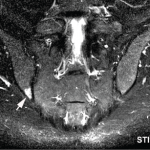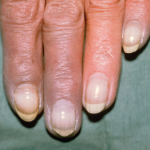In a long-term study, secukinumab proved safe and effective for treating ankylosing spondylitis…


In a long-term study, secukinumab proved safe and effective for treating ankylosing spondylitis…
Will Boggs, MD |
NEW YORK (Reuters Health)—Ixekizumab improves signs and symptoms in patients with radiographic axial spondyloarthritis (ankylosing spondylitis), according to results from the COAST-W study. “Ankylosing spondylitis is a chronic and debilitating disease, and I have a large number of patients who have failed TNF inhibitors,” says Dr. Atul Deodhar from Oregon Health and Science University, Portland….
Lorraine L. Janeczko |
NEW YORK (Reuters Health)—In patients with active non-radiographic axial spondyloarthritis (nr-axSpA) who achieved remission while taking adalimumab, researchers saw fewer flares among those who continued taking the drug than among those who stopped taking it. “The results showed that continued therapy with adalimumab was associated with a higher rate of maintenance of remission compared with…

Catherine Kolonko |
Researchers in Demark studied joints of young adult athletes to better understand the difference in bone marrow edema common in healthy people vs. what is experienced by patients with spondyloarthritis, a serious inflammatory condition of the spine and sacroiliac joints. Early recognition of spondylo-arthritis can be tricky because it can be confused with symptoms and…
Marilynn Larkin |
NEW YORK (Reuters Health)—Risk of myocardial infarction (MI) is increased in patients with spondyloarthritis (SpA) who use the nonsteroidal anti-inflammatory drug (NSAID) diclofenac, but not in those who take naproxen, researchers say. Maureen Dubreuil, MD, MSc, of Boston University School of Medicine, and colleagues analyzed 20 years of medical records from the U.K.’s Health Improvement…
Objective: Low-grade bone marrow edema (BME) has been reported in the sacroiliac (SI) joints of 25% of healthy individuals and patients with nonspecific mechanical back pain, thus challenging the specificity and predictive value of magnetic resonance imaging (MRI) for the identification of early spondyloarthritis (SpA). It is unknown whether stress injury in competition sports may…

In a Phase 3 study, ixekizumab proved safe and effective to treat adults with ankylosing spondylitis (AS)…

When Marc McClintock first began experiencing back pain, he chalked it up to the rigors of his racing career. For more than 36 years, Mr. McClintock has built and raced stock cars, high-powered race vehicles that compete on short oval or circular dirt or paved tracks. “I live in a commercial building, with my residence on…

SAN DIEGO—Top researchers gathered for a review course at the start of the 2017 ACR/ARHP Annual Meeting in November to describe new research, their own treatment strategies and new ways of thinking about an array of rheumatic diseases. Here are the highlights: Raynaud’s & Other Digit Problems When a patient walks into your clinic with…

Innate lymphoid cells (ILCs) in the joints of patients may drive the pathology of spondyloarthritis through the production of granulocyte colony-stimulating factor (GM-CSF). A recent study found that both GM-CSF-producing CD4 T cells and the GM-CSF+ Th17 cells expressed high levels of GPR65—indicating that both GM-CSF and GPR65 may be therapeutic targets for spondyloarthritis…